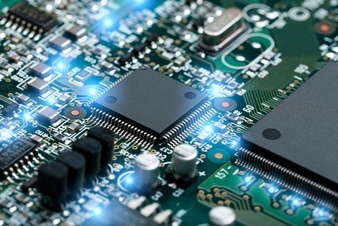What are Digital Electronics?
These are systems and to be specific, electronics systems that use digital signals in the state of ON or OFF or if you want to use coding language or binary format it will be 1 or 0. When we dive deeper into this topic you will see us use terms like logic gates which are the fundamental building blocks, which when combined form complex digital circuits.
Difference between Analogue and Digital?
Analogue signal if we can use that term has properties that vary over a certain time period and elements like temperature observed and measured using analogue devices like the thermometer and wind strength can also be measured using the barometer and this stretched over time would show a graph state that isn’t exact, and recordings will appear on a wavey pattern which is an indication of continuous use of values.
However, digital signals have two states which as mentioned in the intro come in two states, ON/OFF. It does not matter if the current passing through the circuit fluctuating, all that matter is what state is the circuit. If it is a bulb being lit, is it ON or OFF?
Uses of Digital Electronics?
Since early 70s we have seen a tremendous growth in the world of electronics with life-transforming gadgets like the personal computers, televisions, white goods like the home appliances. These systems have become popular since they interface well with systems and therefore easy to control because software can be programmed to make the electronic devices very user friendly.
According to engineers from oemsecrets.com, electronic parts and components search engine, digital electronic systems are an assembly of electronic parts that allow for devices to process, store data and finally transmit that information to an output.
Popular logic circuits you will see in electronics editorials include TTL (transistor-transistor logic), CMOS (complementary metal oxide semiconductor), RAM (random access memory).
Timer/timing circuits and also switching circuits have been replaced by Microprocessors. In simpler terms, microprocessors are now way advanced and are being used in electronic vehicles, medical equipment, fitness gadgets, GPS trackers for dogs and cat trackers, HD TVs.
With greater need for faster gadgets digital electronics is playing a very big role in the way future electronic components are being developed.
Disadvantages of digital electronics
- More energy resource hungry than analogue devices performing the same function
- They can be more expensive especially as they become physically smaller in size
- Prone to quantization errors since the world we live in uses continuous analogue quantities of and the process of translating this will result into errors.
- Fragility in such a way that if small segment of data is corrupt, it will affect the entire set making the results change completely.
These are just the basics of digital electronics; however, you can learn more about the structure of digital systems, waveforms, trade-offs, and the construction of digital circuits. For more information check out free online content from engineering and physics books.




























